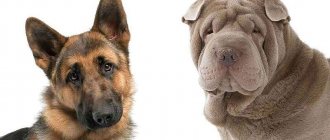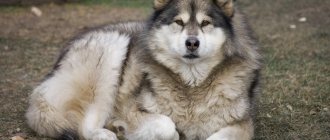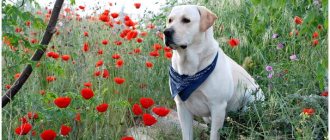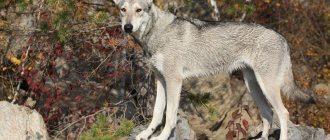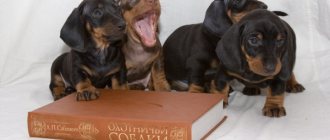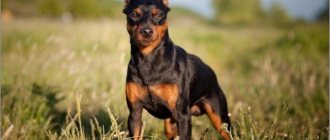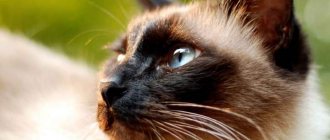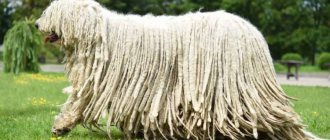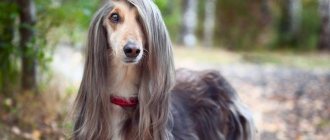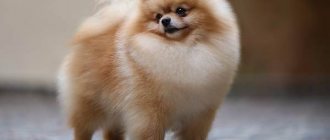Wolf dogs are mysterious creatures that are born as a result of crossing a wolf and a dog. A cross between animals of these two species leads to the birth of a hybrid, which not only looks like a wolf. Even in the 3-4th generation, he can be wary of humans. However, this does not stop wolf dogs from becoming increasingly popular these days.
History of the Czechoslovakian Wolfdog breed
Czechoslovakian Wolfdog
Wolfdog is the “result” of a carefully planned experiment conducted by a group of Czechoslovakian breeders in 1955-1965. The reason that prompted dog handlers to create a new breed was the increased need for guard dogs capable of serving on the border. In most European countries, German shepherds were involved in this work, which at that time had one serious drawback - the breed “retired” too quickly. As a result, even healthy 8-year-old individuals could not withstand competition with young shepherd dogs: the animals lost their visual acuity and sense of smell, quickly got tired, and showed a slow reaction when detaining violators.
In order to get more hardy “service dogs”, they decided to cross German shepherds with Carpathian wolves. The project manager was Colonel and dog handler Karel Hartl, who had previously been involved in “pumping” the phenotype of Czech terriers. The first hybrid litter of puppies was born in 1958 - its parents were the she-wolf Brita and the male German shepherd Cesar. The second time, Brita's partner was the dog Kurt, whose offspring also turned out to be viable and fully met the requirements. Further experiments on breeding wolf dogs continued in a slightly modified form: the mother of the puppies was a female German shepherd, and the father was a Carpathian wolf.
By the 80s, the Czech Wolfdog gradually transformed from a purely service breed into a universal one. It was not the military, but dog handlers, who began to develop the working qualities of its representatives, which also left its mark on the temperament of the animals. In 1982, the descendants of the Carpathian wolf and German shepherd had their own club, and 7 years later the final version of the breed standard was approved for them.
An important nuance: since for several decades wolfdogs have been bred only “in themselves” (the last crossing with a wolf took place in 1983), they are not classified as potentially dangerous to humans hybrids such as wolfdogs.
Video: Czechoslovakian Wolfdog
Wolfdogs
It is not difficult to guess from the name that these are direct descendants of wolves. This is a fairly young breed of dog that was bred in the Soviet Union. Outwardly very similar to wolves, wolf-dogs are nevertheless not afraid of humans and are capable of learning. They were bred for military purposes, as service dogs of the armed forces, and this is where their qualities were most useful. They sense the target better and have sharper hearing. And like any service dogs, they require special treatment. The owner of this dog must be a leader; this breed is not suitable for a beginner.
Breed standard Czechoslovakian Wolfdog
Little top
All members of the family have a strong external resemblance to wolves, but differ from the well-known half-breeds - the wolfdog and the wolfhund. According to the type of constitution, Czechoslovakian wolfdogs are closer to shepherd dogs, therefore they have a less bestial appearance than true hybrid individuals. The minimum allowable height for a male dog is 65 cm; for a female – 60 cm. Sexual dimorphism is also reflected in the weight of animals. If a male Czechoslovakian Wolfdog cannot weigh less than 26 kg, then for “girls” this is more than a decent level, since for them the lower limit of body weight is only 20 kg.
Head
The skull is arched, rounded at the front and sides. With a pronounced occipital protuberance, the frontal sulcus is smoothed and practically invisible. The stop is of medium relief, the narrow muzzle is complemented by a straight bridge of the nose. Cheekbones without a characteristic convexity, but muscular and developed.
Nose
The lobe fits perfectly into the oval shape. The skin color of the nose is uniform black.
Lips, jaws, teeth
The lips, which fit closely to the jaws, do not form hanging “pockets” at the corners, and their edges are painted in a rich black tone. The symmetrically located jaws close in a straight or scissor bite. The teeth are large, with massive developed fangs. The number of teeth approved by the standard is 42.
Eyes
The Czechoslovakian Wolfdog should have slanted and small eyes, with an amber-colored iris. The eyes are covered with thick, dry eyelids.
Predatory look
Ears
Short, classic triangular shape. The thin ear flap is always kept in a standing position. An important breed feature: an imaginary straight line can be drawn between the outer corners of the eyes and the outer corners of the ears.
Neck
The neck of the Czechoslovakian Wolfdog is elongated, dry, with dense, easily palpable muscles. The normal tilt of the neck to the horizon is up to 40°.
Frame
Where is your barrel?
The Czechoslovakian Wolfdog is distinguished by its strong build and rather tall stature. The dog's back is flat, with a slight slope. With pronounced withers, the top line is as smooth as possible. A short loin that does not expand in width is connected to an almost horizontal, well-developed and equally short croup. The pear-shaped chest is not lower than the level of the elbow joints, the front of the chest never protrudes beyond the line of the shoulders. The belly, which is sunken from the sides, is strongly tucked, which gives the animal’s silhouette a pleasant gracefulness.
Limbs
The dog's front legs are located close to each other, with the paws slightly turned outward. The shoulder blades form an angle of about 65°. The shoulders are developed, the elbows are mobile, strong, and stay close to the body. The forearms and metacarpus are elongated.
The hind limbs of the Czechoslovakian Wolfdog are quite powerful, parallel to each other. Massive long thighs form an angle of 80° with the pelvic bones. Flexible knee joints extend into muscular long shins. The joints are strong, with angles of 130°. The hocks are almost vertical.
The dog's paws are elongated, with arched toes ending in strong black claws. The animal moves at an amble (in a calm state) or at a trot (in an excited state), stretching its neck and head forward.
Tail
High rise, hanging down. An excited dog's tail takes the shape of a sickle and rises.
Wool
Czechoslovakian Wolfdogs have a pronounced seasonality of cover. In winter, the coat is thick with a plump layer of undercoat, which is noticeably larger than the guard hair. By summer, the volume of the undercoat decreases, but the outer coat remains quite thick and dense.
Color
Any color is possible in the range from silver-gray to yellowish-gray. There is a light mask on the wolfdog's face. Other areas with lightened coat: chest, inner neck. Not always, but a dark gray color with a lightened mask is allowed.
Disqualifying faults
Me and my crazy friend
- Cowardice or emphasized aggressive behavior.
- Loss of teeth (the absence of two PM1 and one M3 is not counted).
- Weak ligaments.
- Any color other than those specified in the standard.
- Irregular shape of the skull.
- Croup with a sharp slope.
- Availability of suspension.
- The coat does not adhere to the skin and has a soft or wavy texture.
- Incorrectly set tail.
- Ears of an atypical shape, set too high or low.
- The eyes are not slanted, but rounded.
- Incorrect leg position or chest shape.
Exterior defects for which the Czechoslovakian Wolfdog receives a low score at the exhibition: flat forehead, undefined mask, short wavy movements, weak muscles. The iris is also fined if it is dark brown in color, if the eyes are different, or if the head is too heavy or light.
Alaskan Malamute
The Alaskan Malamute is another wolf-like dog that is distantly related to the Siberian Husky. They have the same temperament, coat color and are both used in sled dogs, but that's where the similarities end because the Malamute is a husky on steroids.
In fact, the Malamute is taller and much larger and stronger than the Siberian Husky and is almost equal in strength to the wolf. This is a kind, but at the same time strong-willed and stubborn dog that requires daily training.
Photo of the Czechoslovakian Wolfdog
Character of the Czechoslovakian Wolfdog
Thanks to competent selection work, wolfdogs did not turn into ferocious brutals with the habits of forest predators. Moreover, they absorbed only the best qualities of their wild ancestors - amazing endurance, heightened intuition, high intellectual indicators. However, living side by side with a representative of this breed imposes a number of obligations and is in many ways different from coexistence with a German shepherd. As an example: Czechoslovakian wolfdogs have phenomenal suspicion, and alertness and readiness to repel an attack extend to any strangers. Accordingly, if a new family member has appeared in the house, the animal will not be able to overcome the feeling of mistrust towards him soon.
I'm a woolly wolf! God, how good I am, how powerful my paws are!
The Czechoslovakian Wolfdog is selflessly devoted to its owner. However, it should be clarified here: the pet will adore the person who proved his worth and did not allow the animal to “steer” the situation. If there are other “tails” in the house, the wolfdog will definitely try to climb to the top of the hierarchical pyramid in order to command from there everyone who allows himself to be subjugated. The dog will even try to turn small pets into prey if it is not stopped in time, so there is definitely no place for guinea pigs and domestic rabbits in the same territory as the Czechoslovakian wolfdog.
In addition, this is one of the breeds whose representatives are not particularly fond of children. A child, in the understanding of a wolf dog, is a creature at a higher level of development than a cat, but much lower in level than an adult. Having a Czechoslovakian wolfdog in a family with small children is an unjustified risk, especially if the relationship between the children and the pet is not controlled by adults. Remember that representatives of this family react extremely painfully to disrespectful attitude from children. So if a descendant of the Carpathian wolf lives in the house, explain to your children that hugging, pulling the tail and riding a lying pet can result not only in torn shoes, but also in a trip to the emergency room.
Today's Czechoslovakian Wolfdogs are all-round dogs, capable of guarding a home, repelling an attacking intruder, and setting the tone in agility. True, in order for all the listed skills to “work” correctly, instincts alone are not enough - professional training is necessary. Ordinary dog pranks are also not alien to animals. And since Czechoslovakian Wolfdogs are intellectually ahead of most breeds, their pranks are more thoughtful. For example, teenage dogs masterfully open the doors of kitchen cabinets and gates, masterfully steal food, and also seep into any openings that do not correspond to their dimensions.
Predisposition to pathologies
A kind of incest served as a strong foundation for excellent health. This combination of genetic code made their immunity stable, which is what the discoverer of this species was striving for. These are born long-livers. Their life expectancy is 15-20 years , but even in old age they feel great.
They do not have diseases caused by genes. If there are some flaws, then they are acquired; heredity has nothing to do with it. The resulting ailments are a consequence of improper cultivation. When the body is weakened, resistance to viruses decreases and the risk of injury increases.
For harmonious development and growth, provide balanced feeding. Additionally, give vitamins and mineral complexes. Strengthen ligaments, bones and tendons by taking special medications. The load is only in accordance with age. You can’t keep a baby or an adult locked up, but you shouldn’t drive them to a half-dead state either. Do not forget also about prevention against worms, ticks and fleas.
Education and training
On your own mind - this is roughly how you can characterize the behavior of the Czechoslovakian wolfdog when it has to be involved in the educational process. On the one hand, the wolfdog is intellectually gifted, therefore he comprehends the basic “wisdom” much faster than the same shepherd dogs. On the other hand, the breed is disgusted by useless activities, to which its representatives classify any repeatedly repeated commands and demands. You need to train a dog very carefully, without trying to mold it into an ideal “servant”.
Wolfdog with his owner
Often, owners who have no experience in raising dominant breeds send the animal to canine centers for individual lessons with specialists, but they themselves are completely eliminated. However, the results of such training may be unpleasantly surprising. For example, many organizations do not take into account the wild genes of Czechoslovakian Wolfdogs, applying the same training methods to them as to German Shepherds. As a result, the dog turns into a controlled “robot” with psychological problems that will sooner or later make themselves felt. Therefore, if you do not have enough strength to train your wolfdog, contact a specialist, but always be present at classes and monitor the emotional and mental state of your pet.
If you do not plan to raise your pet as a guard dog, the ZKS course can be neglected. But the OCD is worth going through, even if your dog is an ordinary pet. Czechoslovakian wolfdogs work only for motivation, and it is different for each individual: some are ready to carry out a command for a treat, while for others you will have to find another key, which, most likely, will not work the first time. A common difficulty for wolfdog breeders is practicing the “Voice!” command. The fact is that this highly intelligent breed rarely uses barking, preferring other methods of communication. As a result, mastering the skill takes more time and effort than expected.
Your pet’s stubbornness and reluctance to exercise should also be taken adequately. Every Czechoslovakian Wolfdog comes into a period when it wants to control those around it - usually this is the time of puberty. In such cases, it is better to loosen control a little, give the animal a little more freedom and more often switch its attention to other activities - games, sports, just walks. However, you should not give up the throne of the leader to the “tail” under any pretext - the descendants of the Carpathian wolves are cunning and will not miss the opportunity to play on their master’s weaknesses. Claudia Fugazza’s book “Do as I do” will also be a good help in training. The author has many years of experience working with Czechoslovakian Wolfdogs. Many of the techniques described in the book were successfully practiced on this breed.
Maintenance and care
There is an opinion that the Czechoslovakian Wolfdog is a dog that values freedom and does not take root in city apartments. In fact, the breed is not as demanding of space as they like to attribute to it: an animal that is regularly walked, receives the necessary physical activity and enough attention from the owner, behaves calmly and unpretentiously. Breeders claim that a physically active wolfdog generally “merges” with the surrounding interior.
Woohoo
Loneliness for the Czechoslovakian Wolfdog is the number one phobia that cannot be treated, but can be slightly corrected. Of course, leaving a ward for half a day without receiving torn curtains as a “bonus”, as well as complaints from neighbors about an infernal howl, is an impossible mission. But it is quite possible to train an animal to spend an hour or two without its owner in a disciplined manner.
At first, a cage will help to avoid apartment pogroms. But keep in mind that Czechoslovakian Wolfdogs quickly “disassemble” standard designs for spare parts, and manage to open the latches, so choose the most durable shelter that is protected from dog teeth. In suburban conditions, such a restriction of movement will be an enclosure, which you can build yourself, or you can order it ready-made.
The minimum required number of daily walks for the Czechoslovakian Wolfdog is two, each lasting 1.5 hours. You can walk more - walk, less - no, if you don’t want a hurricane living at home, turning it upside down. To help your dog relax, involve him in games and sports, and come up with new activities, such as sled riding, running behind a bicycle, or lightly towing objects.
Hygiene
You will have to work minimally with the thick, dense fur of the Czechoslovakian Wolfdog. Twice a year the breed sheds profusely, but the hair does not fall out, but simply lags behind the body. At this time, the pet must be combed daily, and dead undercoat must be removed using a slicker. Wolfdogs do not need frequent bathing: their “fur coats” perfectly repel dust and do not absorb liquid dirt. As a result, all contaminants remain on the top layer of the dog and are removed from it naturally. It is best to wash your dog during the shedding period: this makes it easier to remove loose undercoat.
Puppies need to be bathed more often: little wolfdogs are not particularly neat and often get dirty in food bowls, as well as in their own excrement, turning into a walking source of unpleasant odors. The little sluts are not treated with special products so as not to remove the protective fatty lubricant: it is enough to simply wash off the dirt from the fur with a stream of warm water. Cleaning the ears with special drops and lotions is carried out only when wax accumulates. Simply “polishing” the hearing organs of the Czechoslovakian Wolfdog is not only useless, but also harmful.
The breed's eyes are healthy, so the only hygienic procedure recommended for them is preventative wiping with a clean cloth soaked in chamomile decoction. Teeth brushing is also desirable, but it is not always possible to accustom a Czechoslovakian Wolfdog to it. If the toothpaste and brush test does not work, use auxiliary means: hard treats that act as abrasives, tomato juice or ready-made plaque removers added to drinking water.
In the hayloft
Feeding
Both natural and commercial dog foods have both fans and detractors. Although experts who have been working with the breed for a long time recommend making a choice in favor of natural products. The fact is that the body of Czechoslovakian wolfdogs does not absorb starch, which is often added to “drying”. As a result, switching to commercial feed may be accompanied by diarrhea and other unpleasant symptoms. Choosing a brand that is suitable for a dog will have to be done exclusively through experience, which is not always convenient. As a rule, problems do not arise with a natural diet, unless you switch your pet to it from dry food. In this case, an adaptation period accompanied by indigestion is quite likely.
The nutritional base for the Czechoslovakian Wolfdog is meat and its waste: weathered substandard meat, cartilage, tripe. Puppies whose teeth are changing may benefit from occasionally chewing on a sugar bone. Once a week, instead of meat, it is allowed to give sea fish without bones. Cereal porridges with meat broth are not prohibited, but their share in dog food should be small, about 20%. Veterinarians also advise supplementing the natural menu with vitamin complexes, but, as the experience of breeders shows, sometimes special preparations can be replaced with more affordable products. Usually it is recommended to “vitaminize” the diet of Czechoslovakian wolfdogs with chicken yolk, brewer’s yeast, flaxseed oil, and fish oil.
Siberian Husky
This is a direct descendant of the wolf. Considered to be a native sled dog. These fidgets require constant exercise and are perfect for a person with an active lifestyle that they enthusiastically share. She will be a wonderful companion for them. Quite willful, they can run away on their own for a walk. They can bark, but prefer to howl.
They are considered good family dogs and are well suited for families with children, but their needs for significant physical activity must be taken into account.
Health and diseases of Czechoslovakian wolfdogs
Crouching Wolfdog
The genes of the Carpathian wolf made wolfdogs hardy, but they only partially saved them from the diseases inherent in other ancestors. For example, the breed remains predisposed to hip dysplasia. Pituitary dwarfism (dwarfism) is also found among Czechoslovakian wolfdogs - puppies are born with an underdeveloped pituitary gland, suffer from dwarfism, and insufficient thyroid function.
Progressive retinal atrophy passes to some individuals from their parents: the nature of inheritance is autosomal recessive. Rarely, but still there are dogs with degenerative myelopathy, the first symptom of which is considered to be dragging of the hind legs. The disease cannot be treated and is transmitted to offspring even in cases where only one of the producers suffers from it.
Diet
This is a predator, so the basis of the puppy’s diet should be meat. They give it raw, but previously scalded or frozen to get rid of parasites. Ready-made industrial products, the composition of which is designed with a focus on dogs, are not suitable for the digestive tract of half-wolves. Therefore, there is only one diet - natural food.
You can offer your half dog:
- beef;
- a rabbit;
- veal;
- poultry meat, cleared of bones and skin;
- offal.
The wolfdog eats a lot, so before purchasing it, you should seriously think about whether the potential owner will be able to feed this huge predator.
Important! Food for wolf-dogs should be prepared in a separate pan.
It is unacceptable to feed hybrid wolf dogs pork and lamb; this is very fatty meat, which will inevitably cause gastrointestinal diseases. They are also not fed tubular bones or food from the master's table. Clean water must be available and changed at least once a day.
The predatory nature of the wolfdog requires an appropriate feeding regime
How to choose a puppy
- Czechoslovakian Wolfdog females are less adventurous and more manageable than males, so if you want to make it easier for yourself to train your pet, choose “girls”.
- The optimal age for purchasing a puppy is 2-3 months. It is undesirable to take older animals due to the fact that the older the animal, the more difficult it is to socialize it and raise it “for yourself.”
- If you plan to have breed exhibitions, carefully study the documents of the litter producers: examination for the presence of genetic diseases, results of psychological testing (T1), grading code data.
- Don't buy a wolfdog puppy right away. It’s better to book a baby and visit him several times - this way you will see how the Czechoslovakian Wolfdog develops and what character traits it acquires.
- When choosing the most active and courageous puppy, remember that such individuals grow into leaders, who then have constant problems with obedience.
- It would be great if at least one of the litter's sires comes from Czech nurseries, since the best representatives of the breed still live in the territory of the former Czechoslovakia.
- Check whether the seller is ready to provide consulting support to its customers. In serious nurseries, puppies are usually “trained” throughout their entire lives, which is especially valuable for beginning fans of the breed.
Coat
The Saarloos wolf dog, a photo of which can be seen in some cynological publications, has an original coat that can change depending on the season.
In winter, the animal develops a thick undercoat. Together with the guard hair, a layer of fur is formed on the dog’s body, and a thick collar is formed on the neck.
In the spring-summer season, the guard hair becomes the main one. In the autumn-winter period, air temperature can affect the presence of undercoat, but it is important that there is always a tendency for its appearance.
Photos of Czechoslovakian Wolfdog puppies
Czechoslovakian Wolfdog price
The cost of a Czechoslovakian Wolfdog puppy from renowned producers is from 60,000 rubles. It is better to look for purebred representatives in official nurseries like “Romtat”, “Malakhovsky Wolfhound” and others. The cheapest, and sometimes even free, option is adult specimens, which are often sold through virtual bulletin boards. Typical reasons that encourage owners to get rid of their dogs are animal aggression, moving to a new place of residence, a busy work schedule that does not allow them to control the dog’s behavior.
